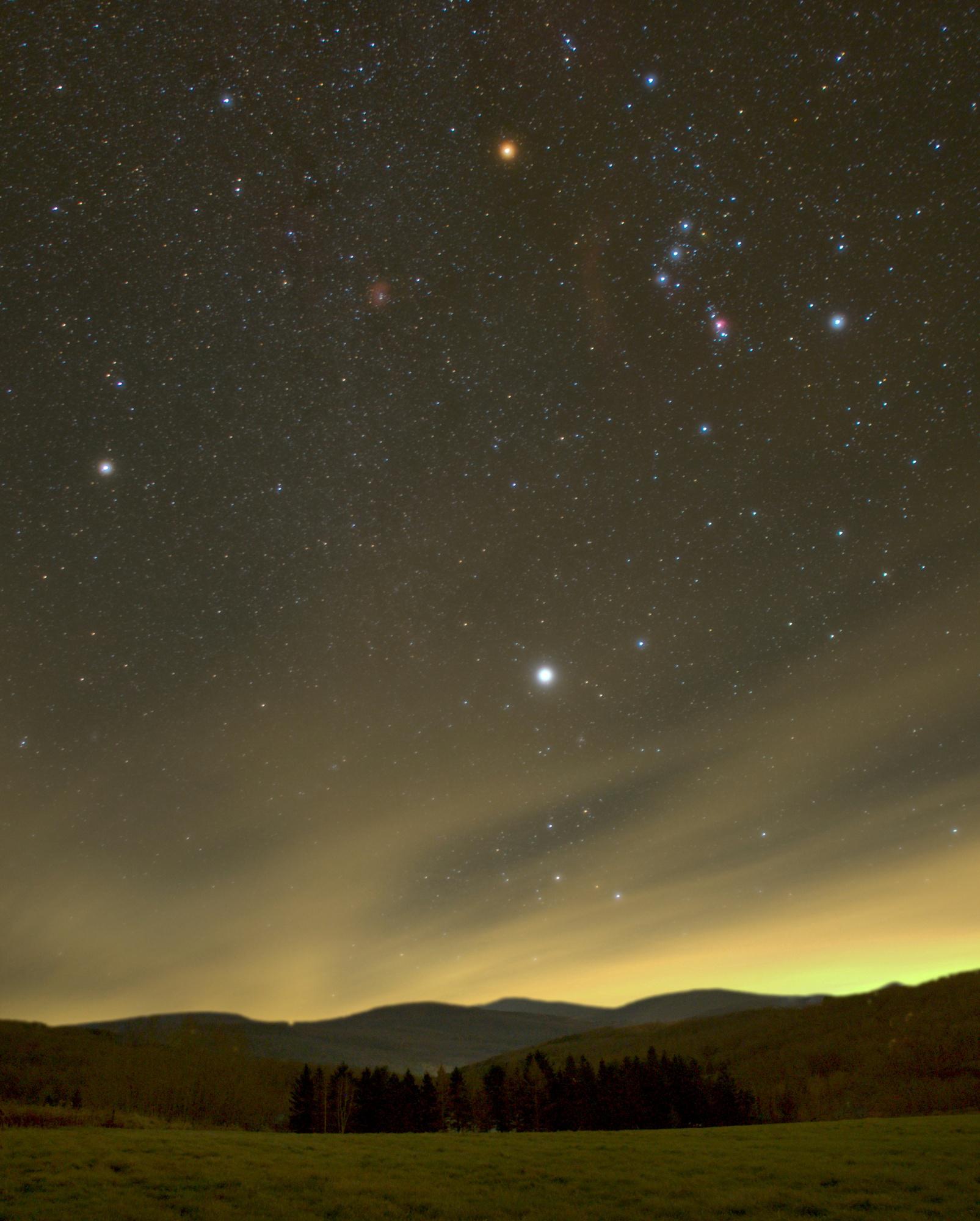Submitted by Star-Fever t3_z7u5i0 in EarthPorn
Comments
Shorty666_ t1_iy8cdnx wrote
Orion is beautiful
quinnwhodat t1_iy8e7v2 wrote
I am partial to his puppers, Sirius and Procyon!
scarlet_stormTrooper t1_iy8hcql wrote
Gorgeous. What area of the Catskills
LeektheGeek t1_iy8mzkc wrote
Most stars always look white or off white to the naked eye
theelljar t1_iy8n2pd wrote
yes that's what i was wondering! so if i wanted to see them like this, I'd need a telescope?
Madouc t1_iy8pwz1 wrote
I have never seen the constellation of Orion in such a way that you can recognise Betelgeuze by its colour.
Shorty666_ t1_iy8qboq wrote
i can always recognize Betelgeuze, odd
Star-Fever OP t1_iy8rkx1 wrote
Yes, you definitely can see star colors if you have a nice dark-sky area. In this pic, Betelgeuse is noticeably orange-red. And Sirius is a bright blue-white. The naked eye can also notice the magenta color of the Great Orion Nebula. Of course, long exposure photos (and vibrance/saturation adjustments) make it all more noticeable, but it's very cool to even get a glimpse of it in real life, out in the dark looking up at the sky.
Star-Fever OP t1_iy8suce wrote
Certain stars are very distinctive. (All of this star-gazing works much better if you go out to a dark-sky area, and sit in the dark — no phone, no flashlight, nothing — and let your eyes adjust for at least a half hour.)
Betelgeuse in this photo is definitely red-orange to the naked eye. Just like seeing Mars and its reddish hue. Antares near the Milky Way core (not visible in winter) is bright red. The Orion Nebula is magenta that can be seen by the naked eye.
Sirius in this photo is blue-white, but if you look around online you might find compilations of how different it can look depending on "seeing" conditions — how light is distorted and refracted in the atmosphere. Sirius, because it is the brightest star in the night sky, gets noticeably color-shifted by this effect sometimes.
Star-Fever OP t1_iy8tcla wrote
It was blazing orange that night, very noticeable to the naked eye. A group of friends and I sat around gazing skyward, in awe at the celestial light show. Several good meteors flashed that night, too — all of which managed to evade my camera....
Star-Fever OP t1_iy8tmhk wrote
This was taken near Halcottsville, in the northwest Catskills. Not far from Roxbury and Margaretville.
Madouc t1_iy8xwm0 wrote
I live too close to Hamburg City - too much light pollution
Star-Fever OP t1_iy90mp2 wrote
Yeah... Light pollution is getting worse everywhere. 😔 I hope someday you can travel to a dark-sky place.... I like to dream about crossing the Pacific Ocean by sailboat. Imagine all those night watches over a thousand miles from any land.
Star-Fever OP t1_iy93nur wrote
Here's an article showing the shifting colors of three different stars, caused by atmospheric turbulence: https://www.skyatnightmagazine.com/astrophotography/astrophoto-tips/twinkling-star-colours/
theelljar t1_iy98fds wrote
wow!! i will try this because it looks so beautiful!! 🤩🤩🤩
Star-Fever OP t1_iy9jass wrote
The thin haze magnified and softened the stars. Juicy! 🌌😋🌌
Star-Fever OP t1_iy9ra76 wrote
CAT-skill . . . More or less. Kinda all run together.
GhostReader28 t1_iya4zlk wrote
How did you take this photo? I want to do a bit of Astro photography but not sure where to start.
Star-Fever OP t1_iyaswwx wrote
I used a Sony a7iii with a Sigma DC DN 16mm lens, and took six long exposures in succession, and then stacked them in Sequator (free software), with a light-pollution reduction. But any camera with a manual mode that allows you to adjust ISO and shutter speed could work. And a cheap tripod works just fine... What equipment do you have?
CombinationAway2762 t1_iyayrgu wrote
Orion Nebula.. 😍
Mr--Joestar t1_iyb86kc wrote
How long were your exposures?
toastibot t1_iybm4e0 wrote
Hi and welcome to r/EarthPorn! As a reminder, we have comment rules in this subreddit. Failure to follow our rules can result in a temporary or permanent ban.
> Hate Speech, Abusive remarks, homophobia, and the like have no place on this subreddit, and will be removed on sight.
> Please contribute to the discussion positively; constructive criticism is fine, but if you don't like a picture and you wish to voice your opinion please refrain from abusing the photographer/submitter.
spongedog001-a t1_iybvbv2 wrote
I wish I had that kind of star view. Even down here in Arkansas you can't even make out the shape of the milky way anymore even when the most dense part of it is out. its sad how most people who live in the U.S Will never get a chance to see the the milky way properly. at least not without having to drive out of their way to go see it and there isn't that many full dark sky sites anymore down here.
Star-Fever OP t1_iyctsye wrote
20 seconds each. The maximum length of star exposures is usually governed by the "rule of 500" so you don't get oblong stars or star trails in each frame. Divide 500 by the focal length of your lens (and use full-frame equivalent for APS-C cameras). That'll give you a good exposure time in seconds.
Star-Fever OP t1_iydqsot wrote
Yeah... Even in our rural corner of upstate New York, the artificial lights just increase constantly, never decrease. 🙁

AutoModerator t1_iy83fo9 wrote
Hi Star-Fever! Dont worry, this message does not mean that your post is removed. This is a reminder to quickly check your post to make sure it doesnt break any of our rules. Human moderators check the following --
some visible land, that is not silhouetted
no human-made objects (roads, boats, buildings) visible
no obvious people or animals visible
include location in post title
Thanks!
I am a bot, and this action was performed automatically. Please contact the moderators of this subreddit if you have any questions or concerns.